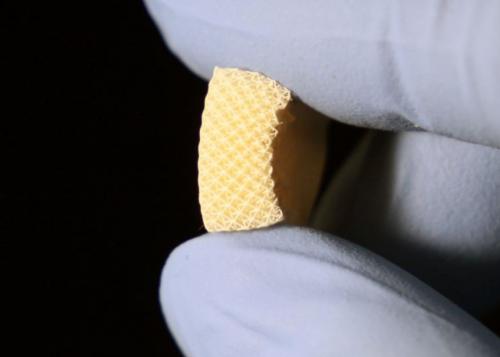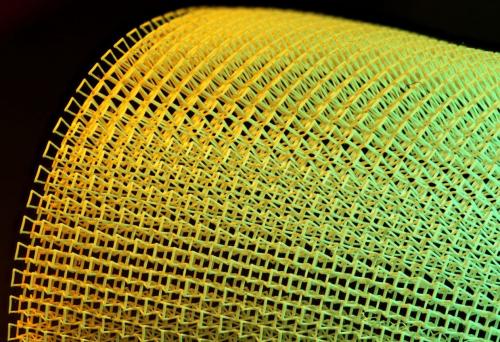
Virginia Tech engineers have developed a new process to 3D print energy-harvesting piezoelectric materials. Piezoelectricity is the ability of some crystals to generate a voltage (electricity) in response to applied mechanical stress.
The piezoelectric materials that exist in many products we use today may be getting an upgrade, say the engineers. Piezoelectric materials inhabit, for example, our mobile phones and musical greeting cards.
The researchers wrote about their work in the prestigious journal Nature Materials (citation below). The authors, all from Virginia Tech at the time of writing, were Huachen Cui, Ryan Hensleigh, Desheng Yao, Deepam Maurya, Prashant Kumar, Min Gyu Kang, Shashank Priya, and Xiaoyu (Rayne) Zheng.
The authors explained how they found a way to 3D print piezoelectric materials. They can be custom-designed to convert stress, impact, and movement into electricity.
Xiaoyu ‘Rayne’ Zheng, an Assistant Professor of Mechanical Engineering in the College of Engineering, said:
“Piezoelectric materials convert strain and stress into electric charges.”
Piezoelectric materials
The piezoelectric materials, made of brittle crystal and ceramic, come in only a few defined shapes. They require a clean room to manufacture.
Prof. Zheng’s team has developed a way to 3D print these materials so that they are not restricted by size or shape. It is also possible to activate the material.
Their technology has paved the way for the next generation of intelligent infrastructures and smart materials, the authors wrote. Specifically, materials for tactile sensing, energy harvesting, impact and vibration monitoring, and other applications.
We have known about piezoelectric materials since the nineteenth century. Advances in manufacturing technology since then have led to the requirement of clean rooms and complex procedures to produce films and blocks. Manufacturers add these blocks and films to electronics after machining.
Adding piezoelectric materials is expensive. They are also inherently brittle. These two factors have limited our ability to get the most out of them.
Manipulating and designing arbitrary piezoelectric constants
According to a Virginia Tech press release:
“Zheng’s team developed a model that allows them to manipulate and design arbitrary piezoelectric constants, resulting in the material generating electric charge movement in response to incoming forces and vibrations from any direction via a set of 3D printable topologies.”
“Unlike conventional piezoelectrics where electric charge movements are prescribed by the intrinsic crystals, the new method allows users to prescribe and program voltage responses to be magnified, reversed, or suppressed in any direction.”
Prof. Zheng said:
We have developed a design method and printing platform to freely design the sensitivity and operational modes of piezoelectric materials.”
“By programming the 3D active topology, you can achieve pretty much any combination of piezoelectric coefficients within a material and use them as transducers and sensors that are not only flexible and strong, but also respond to pressure, vibrations, and impacts via electric signals that tell the location, magnitude, and direction of the impacts within any location of these materials.”

3D printing of sensors, transducers, and piezoelectrics
The natural crystal used is a factor in current piezoelectrics fabrication. The orientation of atoms, at the atomic level, is fixed.
Prof. Zheng’s team has created a substitute that mimics the crystal. However, it allows scientists to change the lattice orientation.
Prof. Zheng said:
“We have synthesized a class of highly sensitive piezoelectric inks that can be sculpted into complex three-dimensional features with ultraviolet light.”
“The inks contain highly concentrated piezoelectric nanocrystals bonded with UV-sensitive gels, which form a solution – a milky mixture like melted crystal – that we print with a high-resolution digital light 3D printer.”
The researchers demonstrated the materials which they had 3D printed at a scale measuring fractions of the diameter of a strand of human hair.
Many different shapes and sizes
Prof. Zheng said:
“We can tailor the architecture to make them more flexible and use them, for instance, as energy harvesting devices, wrapping them around any arbitrary curvature. We can make them thick, and light, stiff, or energy-absorbing.”
The material is five times more sensitive than flexible piezoelectric polymers. The material’s shape and stiffness can be tuned and produced as a stiff block or a thin sheet.
Prof. Zheng said:
“We have a team making them into wearable devices, like rings, insoles, and fitting them into a boxing glove, where we will be able to record impact forces and monitor the health of the use.”
Shashank Priya, a former Professor of Mechanical Engineering at Virginia Tech, who is today an Associate Vice President for Research at Penn State, said:
“The ability to achieve the desired mechanical, electrical, and thermal properties will significantly reduce the time and effort needed to develop practical materials.”
“Here, the structure itself is the sensor.” Piezoelectrics are about to get a lot more useful, thanks to @VTEngineering researchers. https://t.co/6Cp65qj8bb
— VT ICTAS (@ICTASVT) 28 January 2019
3D printed piezoelectric materials – new applications
The researchers have printed and demonstrated smart materials worn on hands and fingers and wrapped around curved surfaces. The materials convert movement and harvest the mechanical energy.
However, the applications go far beyond consumer electronics and wearables, the authors added. Zheng sees potential in robotics, tactile sensing, and energy harvesting, where the structure comprises 100% piezoelectric material, sensing vibrations, motions and impacts.
According to a Virginia Tech press release:
“The team has printed a small smart bridge to demonstrate its applicability to sensing the locations of dropping impacts, as well as its magnitude, while robust enough to absorb the impact energy. The team also demonstrated their application of a smart transducer that converts underwater vibration signals to electric voltages.”
First author, Huachen Cui, a doctoral student with Zheng, said:
“Traditionally, if you wanted to monitor the internal strength of a structure, you would need to have a lot of individual sensors placed all over the structure, each with a number of leads and connectors. Here, the structure itself is the sensor – it can monitor itself.”
3D printing
3D printing is a type of manufacturing in which you add layer upon layer. You keep adding until you have your desired product or object. It is a type of additive manufacturing.
It contrasts with subtractive manufacturing, which works the other way round. With subtractive manufacturing, you remove (subtract) parts until you have your desired product. You may start, for example, with a block. You then chip away at it until you have what you were indenting to make.
Citation
“Three-dimensional printing of piezoelectric materials with designed anisotropy and directional response,” Huachen Cui, Ryan Hensleigh, Desheng Yao, Deepam Maurya, Prashant Kumar, Min Gyu Kang, Shashank Priya, and Xiaoyu (Rayne) Zheng. Nature Materials (2019). DOI: https://doi.org/10.1038/s41563-018-0268-1.
